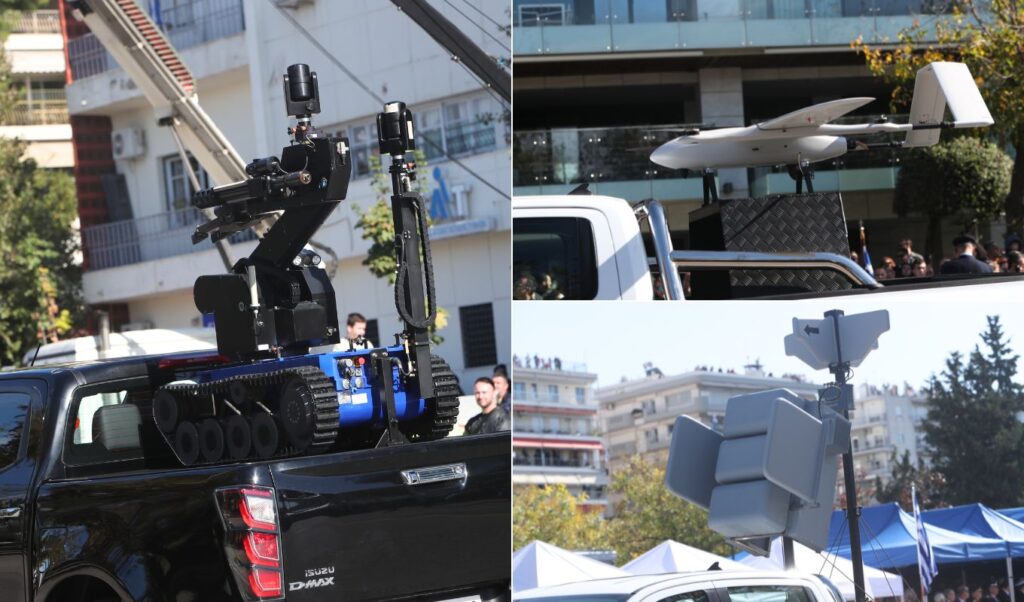The military parade in Thessaloniki was completed with great splendor for another year as part of the celebrations for the national anniversary of October 28th, with new weapons systems stealing the spotlight. It should be noted that in today’s military parade, the Innovation and New Weapons Systems Department was presented for the first time, an initiative that is part of the Ministry of National Defense’s “Agenda 2030” and the new deterrence doctrine.
The systems that citizens of our country had the opportunity to observe, either up close or through the parade broadcast, are part of “Achilles’ Shield” — an integrated protection network with multiple defense levels, where advanced technology combines with military experience. Drones, autonomous maritime vessels, as well as surveillance, communication and network-centric control systems are at the center of a dynamic transformation leading the Armed Forces into the new era.
As Minister of National Defense Nikos Dendias emphasized, “with Agenda 2030 as a roadmap for deep reform, the New Force Structure, the 12-year Long-term Defense Equipment Planning and the introduction of cutting-edge technologies, we are building the most powerful and modern Armed Forces in the history of Modern Greece.”
October 28th: The 16 new weapons systems that stole the show in Thessaloniki
Heron
The Heron drone has autonomy exceeding 40 hours and flight capability at altitudes above 30,000 feet. It can cover distances over 350 km, providing real-time imagery.

M1117
Four American-origin M1117 Armored Security Vehicles followed, which were recently integrated into the Greek Army. These specific vehicles carry electronic sensors designed and manufactured exclusively by the 306 Base Factory of the Land Army. They feature high-definition cameras and drone systems. They constitute autonomous surveillance systems capable of transmitting real-time imagery to Operations Centers.

Spike Nlos
This is a new precision missile system, multi-role, capable of engaging targets up to 32 kilometers away. Recently integrated into the Land Army. Part of it is the ORBITER Unmanned Aircraft System, which can identify targets at depths up to 50 kilometers, transmitting imagery and firing data in real time.

“Centaurus” anti-drone system
The “Centaurus” system is an anti-drone system capable of detecting and neutralizing enemy drones through electronic jamming. It is the result of collaboration between the Greek Defense Innovation Center and the Hellenic Aerospace Industry. It has already been installed on Navy frigates operating in the Red Sea as part of Operation “Aspides,” with excellent results.

“Hyperion” drone detection and neutralization system
The “Hyperion” drone detection and neutralization system is the evolution of “Centaurus.” It is in advanced testing stages by the Hellenic Aerospace Industry. It has the capability to automatically detect and neutralize attacking drones through jamming, providing 360-degree coverage for our Units.

S-100 drone
This is a state-of-the-art drone included in the equipment of the new Belharra (FDI HN) frigates. It has the capability to detect, identify and target with precision and without operator intervention potential threats at depths up to 100 kilometers.

“Archytas” drone system
This is a product of collaboration between the Naval Academy, the School of Electrical Engineers of the National Technical University of Metsovo and private sector companies of our country. It has vertical landing and takeoff capability so it can operate both from land and from warships. Maximum flight altitude approaches 5,000 meters while its autonomy reaches 2 hours. It can undertake long-range reconnaissance and surveillance missions. It already participates in exercises and operations of Navy frigates, both within and outside Greek territory.

“A900” drone
This is an unmanned helicopter used by Navy ships. Equipped with modern technology electro-optical systems, it provides live transmission of clear surface imagery at depths of 30 kilometers.

“Rotinor” underwater scooter
An underwater diver assistance vehicle used in special diving missions. Used by Underwater Demolition Units for covert, silent, and rapid penetration into the area of operations.

VTR speedboat
This is an Unmanned Surface Speedboat of the Special Warfare Command. Developed by the Armed Forces Research, Technological Development and Innovation Center. It is a combination of an operational speedboat of the Greek Special Forces and an autonomous navigation system with obstacle detection and avoidance capability. Its mission is surveillance and observation of maritime targets through thermal cameras, identification radar and satellite.
EOD engineer robot
Two general-purpose vehicles carrying three robotic systems for neutralizing Improvised Explosive Devices. They enable remote bomb neutralization without requiring personnel to approach the area.

SHMEA (V-BAT)
Four “V-BAT” Unmanned Aircraft Systems. This is one of the few drone systems worldwide with vertical takeoff/landing capability, which increases usage flexibility. The system’s flight autonomy makes it capable of surveillance at depths of 200 km for extended periods. It undertakes surveillance-reconnaissance and targeting missions, while also participating in search-rescue operations.

Mobile drone production unit
Two Autonomous Unmanned Aircraft Production Units. Manufactured by the 306 Technical Base Factory, they feature modern equipment and 3D printing devices for producing drone spare parts on the battlefield. They can produce up to 1,000 Type 1 FPV (First Person View) drones per year on-site and provide technical support to Units using Unmanned Aircraft.

Tactical command and control station
The Mobile Command and Control Station is an autonomous Operations Control Center. Equipped with modern communications means and digital applications, it transmits real-time battlefield imagery.
“Metoikos” portable communications station
The “Metoikos” Portable Communications Station constitutes an autonomous and flexible communications node, designed and assembled by the Air Force’s Telecommunications and Electronic Equipment Factory (ETEM). It is a state-of-the-art, high operational value telecommunications system capable of restoring or augmenting communications in any environment and under any conditions.
“Deucalion” tactical natural disaster response station
This is a Mobile Operations Center designed to direct and coordinate natural and technological disaster response operations. Equipped with modern telecommunications systems, “DEUCALION” provides communication capability with land, sea and air assets of the Armed Forces and civil protection. It features Unmanned Aircraft and thermal and optical observation cameras.




